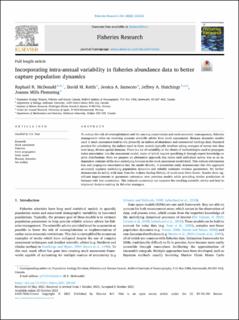Incorporating intra-annual variability in fisheries abundance data to better capture population dynamics
McDonald, Raphaël R.; Keith, David M.; Sameoto, Jessica A.; Hutchings, Jeffrey; Flemming, Joanna Mills
Peer reviewed, Journal article
Published version
Permanent lenke
https://hdl.handle.net/11250/3001742Utgivelsesdato
2022Metadata
Vis full innførselSamlinger
- Articles [3011]
- Publikasjoner fra CRIStin [3061]
Sammendrag
To reduce the risk of overexploitation and the ensuing conservation and socio-economic consequences, fisheries management relies on receiving accurate scientific advice from stock assessments. Biomass dynamics models used in stock assessment tend to rely primarily on indices of abundance and commercial landings data. Standard practice for calculating the indices used in these models typically involves taking averages of survey tow data over large, diverse spatial domains. There is a lot of variability in the choice of methodologies used to propagate index uncertainty into the assessment model, many of which require specifying it through expert knowledge or prior distributions. Here we propose an alternative approach that treats each individual survey tow as an independent estimate of the true underlying biomass in the stock assessment model itself. This reduces information loss and propagates uncertainties into the model directly. A simulation study demonstrates that this approach accurately captures underlying population dynamics and reliably estimates variance parameters. We further demonstrate its utility with data from the Inshore Scallop Fishery of south-west Nova Scotia. Results show significant improvements in parameter estimation over previous models while providing similar predictions of biomass with less uncertainty. This reduced uncertainty can improve the resulting scientific advice and lead to improved decision-making by fisheries managers.
